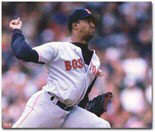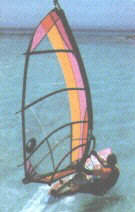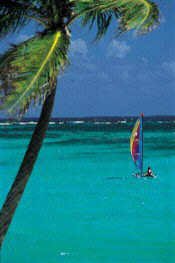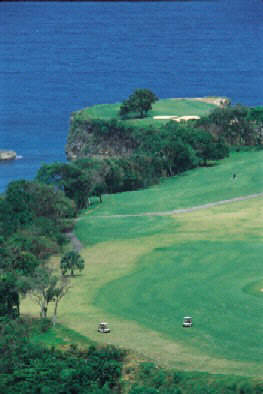 SPORTS SPORTS |
 BASEBALL, NATIONAL PASSION BASEBALL, NATIONAL PASSION |
Baseball was first introduced in the Caribbean in 1866 through Cuba by American sailors who were there to load sugar and eventually taught the sport to Cubans. Eight years later in 1874 the first organized game of baseball was played between Cuban teams. In the years to come it would be Cuba who would spread baseball throughout the Caribbean. When the ten year war (1868-1878) in Cuba brought turmoil to the country, many Cubans fled their country and migrated to the D.R. bringing with them the game called "Baseball" or "Beisbol."
Dominicans were quick to learn the game and soon tournaments were being held with organized teams.
Four teams were formed, becoming the oldest and founding teams of baseball in the Dominican Republic:
Tigers del Licey (The Tigers) - Santo Domingo 1907
Estrellas Orientales (Eastern Stars) - San Pedro 1911
Sandino - 1921
Renamed Las Aguilas (The Eagles) 1936
Los Leones del Escogido (Lions of the Chosen One) - Santo Domingo 1921.
When Rafael Leonidas Trujillo first came to power in 1930 he soon controlled most of the Dominican economy and used his influence to eliminate competition, subsequently establishing monopolies. It was after the 1936 Dominican Baseball League was finished that Trujillo took an interest in baseball. Knowing his people and the love of baseball they had, he dedicated the 1937 Dominican Baseball League to his re-election. To Trujillo's advantage he merged the two rival teams from Santo Domingo (Licey and Escogido) to play in that year's Dominican Baseball league. He then renamed the team "Ciudad Trujillo Dragons" after him and the city of Santo Domingo, which he had renamed "Ciudad Trujillo" after he had taken power. These two teams would only be merged together for one year, the 1937 series.
The three-team league of 1937 brought together some of the best players money could buy. Santiago (Las Aguilas) acquired the skill of such players as Luis Tiant, Martin Dihigo and Horacio Martinez. San Pedro (Estrellas Orientales) came back with Tetelo Vargas, Ramon Bragana and Cocaina Garcia. Trujillo took one look at the rival teams line up of talent and countered with Josh Gibson, Cool Papa Bell and Satchel Paige from the Pittsburgh, Crawford's (Pirates). The 1937 baseball league would be remembered by many. Baseball was played at its best and it would be the "Ciudad Trujillo Dragons" who would prevail and win the series, but it would come with much sacrifice for the country. Due to the financial toll the country took for buying some of the best players to play in the series, professional baseball would come to an end for fourteen years. There are many who say the sacrifice was just too high.
While pro baseball took a hiatus, Amateur baseball matured. International Championships were being played throughout the Caribbean with teams coming from the United States and the Caribbean. In 1948 the Amateur Baseball team from Dominican Republic won the championship. This came only months after the team's plane crash near Rio Verde. Only a few survived but it sparked those fortunate to survive to win the series. Pro Baseball returned to the island in 1951 with the help of the Dominican International team and backing from wealthy prominent citizens. The league consisted of the original four- Licey, Escogido, Aguilas and the Estrellas. In 1955 the Quisqueya Stadium was built in Santo Domingo (Ciudad Trujillo) and on October 23 of that year the first night game was played on the island. That same year pro baseball would take on a new schedule of a winter series while amateur ball would now be played in the summer.
The winter league World Investment News Ltdrs of the Caribbean Islands have met in the "Serie Del Caribe" since 1949 to determine the champs of the Caribbean. Between 1949 and 1960 the countries of Cuba, Panama, Puerto Rico and Venezuela had played in early February to determine the champion of the Caribbean. The series was discontinued after 1960 because of the Cuban revolution, but in 1970 it resumed with the Dominican Republic and Mexico replacing Cuba and Panama. It was not uncommon to see many of the minor league players of the major league teams from the United States play in these games but by the mid 1980 fewer returned to the islands to play due to risk of injury and the physical demands of the regular season.
 Baseball in the Dominican Republic Today Baseball in the Dominican Republic Today |
The national sport and passion of Dominican Republic is baseball or "Beisbol" as the Dominicans call it. No matter where you go on the island you will find a baseball stadium/park, even in the poorest of towns. Today more than one in six players in the American league is from Latin America, the majority of them coming from the towns located on the southeastern coast of the Dominican Republic.

The sugar mill towns (San Pedro de Macoris, La Romana) have long been a part of Dominican Baseball. The history of baseball in these towns can be traced back as far as the Cuban immigration to the Dominican Republic. Dominican and American Mill owners approved the sport and encouraged their workers to participate in it. The six months of "dead" season when sugar cane requires the least maintenance and the workers were unemployed helped contribute to the development of baseball in this area. Soon, championships were set up to pit one sugar mill against the other. Baseball was not just a sport to these people but was bred into each child born.
The recruiting of young baseball players has become a year round job here. More than 20 major league teams now have baseball-training camps for prospective players. Scouts from these teams are sent out to hold try outs throughout the island. Those who are lucky enough to make the team are usually young boys between the ages of 17 and 18. Once selected they are sent to the teams camp where they are housed, fed and taught baseball. The average player will make about $800.00 a month.
These young players will compete in the Summer League, which consists of various training camps in a two-division league. If a prospect shows promise, he is then promoted to the minor league system in the states with hopes of making it to the major leagues. But for every new star that is born, hundreds will not make it.
| Today there are six teams, which play in the pro baseball league in the Dominican Republic. The original four -Licey, Escogido, Aguilas and the Estrellas plus the Azucareros del Este from La Romana and the Pollos Nacionales from San Francisco de Macoris. There is rumor that a seventh team will join this year's league (2002) from Puerto Plata. Winston Llanos once quoted of the Dominican Baseball League, "It's more than just a game. It is our passion. It's almost our way of life," and there is nowhere else that you can experience baseball at its best than in the Dominican Republic."
Thanks to baseball men of poor origins like Sammy Sosa, Pedro Martinez, Alex Rodriguez, Manny Rirez and many others, proudly carry the Dominican Flag in the international arena...
 WINDSURF AT CABARETE WINDSURF AT CABARETE |
Cabarete is known as the Windsurfing capital of the world. The trade winds in Cabarete produce tremendous waves, attracting both novice and world class surfers. Cabarete has hosted 5 World Windsurfing Championships, offering competitors perfect conditions in a beautiful setting. June is the windiest month of the year with side-shore winds 15 to 25 knots.

 SURFING AND BODYBOARD SURFING AND BODYBOARD |
Cabarete celebrates important events at Encuentro Beach, 5 min from town. Important events include " Encuentro Classic" and "Wave spirit". They had 3 years of success and competitors score in competitions of the Surf & Body board Tour.
 FLYSURFING FLYSURFING |
Cabarete is on top of the news in water sports; here it hosted one of the seven worldwide competitions in the 1st Kiteboard Pro-Tour. Tierry Calvignae introduced the country to this sport, which uses surf and a kite.

Sailing on crystal clear waters
 DISCOVER THE CARIBEAN'S MOST EXCITING GOLF DESTINATION DISCOVER THE CARIBEAN'S MOST EXCITING GOLF DESTINATION |
The Dominican Republic is known for many things: Christopher Columbus' entrance to the Americas, baseball superstars, sugarcane and cigars. But soon it will be known as one of the premier golf destinations in the Caribbean as well. With four (soon to be six) Dye-family courses and two Robert Trent Jones Sr. tracks, the designer-holes-per-capita count here makes this country a veritable golf powerhouse.
And in a country twice the size of New Hampshire, the beauty is that you can play them all !!!

Golf in Playa Grande
The majority of the courses are found along the coast in the country's burgeoning resorts, each with his own distinct identity
· Casa de Campo
· Catalonia Bavaro
· Coral Hotel $ Resorts
· Metro Country Club
· Playa Grande
· Playa Naco Golf & Tennis Resort
· Puerto Plata Village
· Punta Cana Resort and Club
· Sol Melia
· Victoria Resort |

